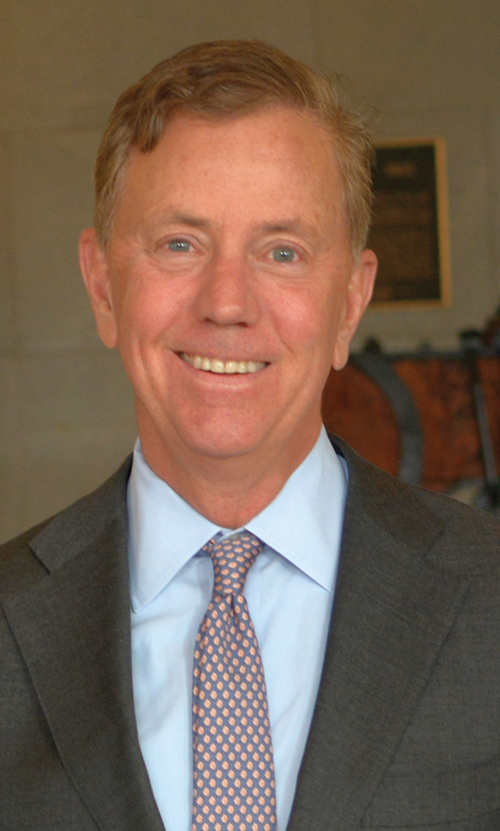Governor Ned Lamont delivered his biennial budget address to state legislators on February 10th, six days before speaking with yours truly, a Connecticut native, via a Zoom call. In both instances he made it clear that it’s a new era in the Constitution State. For one thing, the governor was candid, if not blunt, about the state’s reputation as a high-cost location for business. But he understands that you can’t fix a problem until you admit it exists.
“We’ve been out of favor for the last 10 years,” noted Lamont on the Zoom meeting. “Being a high-cost state was our reputation. I’d like to think that’s turning around. One small reason for that is I’m the first business guy to be in this seat in a long time.” The governor’s background is in telecommunications.

“I’ve always said we don’t need more taxes, we need more taxpayers.”
Delivering fiscal stability and predictability is a key objective of the governor, who took office in January 2019. “I held the line on taxes,” he relates. “I got our budget balanced in year one and in year two, with a surplus in year two. The next two years will not be a walk in the park, but we’ll do it without raising taxes.”
That’s where the 2022-2023 biannual budget address, Connecticut’s Comeback, comes in. Following are several excerpts that signal Governor Lamont’s intention to steer the state in a more pro-business direction.
Balanced Budget
“One of my top priorities has been to get Connecticut’s fiscal house in order. My first stop two years ago was the state’s budget. For decades, Connecticut was defined by one fiscal crisis after another. Which is why when I spoke to you at my first budget address, I challenged us to pass an honestly balanced budget on time.

“The budget we passed together, on a spring day rather than in the middle of an autumn night, resulted in a small surplus in year one and, so far so good, a bigger surplus in year two. We did so without broad-based tax increases, without cuts to public services or cuts to our cities and towns, and we did so while building the largest budget reserve in our state’s history. Despite a global pandemic which threatens every aspect of our society and economy, we stayed the course, weathering the storm, and our state has begun to find its economic footing.”
Fixing Future Deficits
“The Connecticut budget is still burdened with high fixed costs accumulated over the decades, and these costs plus a COVID economy result in deficit projections in each of the next two years. With our continuing success in streamlining government, we have reduced projected deficits to less than $1 billion annually, which will be balanced by either: a gradually growing economy; state and local aid from Washington; or a partial drawdown from our $3.5 billion rainy day fund.”
Workforce Development
“Last fall, I announced the formation of the Office of Workforce Strategy, with a dedicated focus on the current and future workforce needs of the economy. As a state, we need to educate and train our workforce for these future opportunities. My proposed budget, and supporting legislation, reflects the continued commitment.

“Kelli Vallieres, Connecticut’s first Chief Workforce Officer, and I will be working with our community colleges and the Connecticut State Colleges & Universities system to build on our certificate programs to provide the skill set for jobs which are in high demand for skilled workers, such as advanced manufacturing, coding, construction, nursing, digital media. The certificate program provides you with a path to a job at less cost in less time than a traditional degree.
“A high-quality workforce development program will ensure better outcomes for our state’s residents and help our businesses to hire from and continue to grow here in the state.”
Infrastructure Funding
“I am sending a bill to the legislature to provide expanded broadband access for those communities large and small which have been left behind in the digital revolution. Look, we’re by no means certain how pandemics are accelerated by changes to our environment. Our environmental efforts continue to be viewed through the lens of public health, new green jobs and environmental justice, which means reducing our dependence on out-of-date energy solutions, such as coal and antiquated trash-to-energy plants, which are spewing pollution particulates into the air. This airborne pollution hits our urban communities the hardest, creating those same comorbidities which make you much more susceptible to disease and infections, like asthma and COVID-19.
“As for our transportation infrastructure and funding, if the thinking had been, ‘If it ain’t broke, don’t fix it,’ then that thinking needs to change. This is personal. Annie and I went over the Mianus River Bridge down in Greenwich a few hours before it collapsed a generation ago. So I know. The Special Transportation Fund is broken and it needs to be fixed.”
Real Estate Boom
“Over the last year, we’ve experienced a real estate boom in Connecticut. With tens of thousands of new residents discovering what they’ve always known, that Connecticut is a beautiful state with beaches, mountains and parks all within a short drive from one another, great schools which were more likely to be open and open safely, not to mention expanding job opportunities.
“In Hartford County alone, this past December saw a 50% increase in sold single-family homes compared to the previous December, in a similar trend all across the state and one we must continue to support and encourage. I’ve always said, we don’t need more taxes, we need more taxpayers, and they are already paying dividends as you can see by our balanced budget.”
Back to the Site Selection interview in February, Governor Lamont stressed the importance of his and the business community’s role in getting the word out about Connecticut being more than a high-cost area between New York City and Boston. Take a closer look, he urges.

“We may be high cost in some categories but not in others,” he acknowledges. “You can get a very high quality workforce at less cost because we have high quality public schools and real estate is less expensive. For construction we may be more expensive but no more so than our peers. We have the cleanest and most reliable electricity in the country. Energy costs are a bigger and bigger piece of manufacturing, but we have a 15-year deal with Dominion Millstone, a nuclear power plant, so those costs are fixed. That’s a big step.
“My main priority is our workforce,” says the governor. “We’re doubling down on that, working with our major businesses and getting a much better fix on who they need to make sure that they don’t have to go beyond our borders to find that. I feel very comfortable with the business community, but I need businesses to be champions for Connecticut.”
Plenty of Connecticut businesses are happy to champion the state. They are there because they want to be there, and they believe other companies in their industry would benefit from a Connecticut location as well. For their perspective, Site Selection turned to corporate executives in three of the state’s leading industries — defense, life sciences and IT. Each were asked the same questions about doing business in Connecticut.
Participants in this exercise are Elizabeth Power, director of communications at defense contractor and submarine builder General Dynamics Electric Boat, Groton; Eric Schadt, founder and CEO of Sema4, an AI-driven, patient-centered genomic and clinical data insight platform company in Stamford; and Jeff Auker, Tech & Innovation Hub Lead at Infosys, a digital services and consulting firm that recently opened a Technology and Innovation Hub in Hartford. Following are their responses.
Describe your operations in Connecticut — brief history, location, workforce and business line.
Elizabeth Power, Electric Boat: Electric Boat designs, manufactures and repairs submarines for the U.S. Navy. Established in 1899, Electric Boat moved to Groton in 1913. Today, EB has more 17,000 employees, more than 12,000 of whom work in Connecticut. The majority of our employees work at our Groton shipyard and our office complex in New London. We also have other smaller satellite office locations. We also have more than 4,000 employees, mostly dedicated to manufacturing, located at our Quonset Point, Rhode Island, campus.
Eric Schadt, Sema4: We selected Stamford as our corporate headquarters in 2017 when we launched the company. We have rapidly grown over the last few years. Sema4 now has over 550 employees in Connecticut, a number that has more than quadrupled since 2017. In addition to our HQ, we have two state-of-the-art clinical laboratories and research facilities in Branford and Stamford. The former was expanded earlier this year to meet greater demand and deliver new capabilities, including COVID-19 testing. The latter officially opened in December and is designed to process thousands of industry-leading, information-based genomic tests a day and to further support our mission of advancing healthcare through data-driven insights.
Jeff Auker, Infosys: Our work for clients in Connecticut extends back at least three decades, providing a wide range of IT services, application development, and digital transformation for many of Connecticut’s largest employers. For most of that time we did our work onsite at our clients, with a small administrative office in Glastonbury. In December 2019, Governor Malloy, Governor-elect Lamont, Mayor Bronin and other dignitaries joined us to inaugurate our third U.S. Digital & Innovation Hub in the Goodwin Tower in downtown Hartford. More important than the 56,000 square feet of real estate we invested in, Infosys committed to bringing 1,000 local jobs to Connecticut within five years, and we are well on our way to that goal.

How would you grade the state’s overall business climate in terms of such factors as ease of doing business, the regulatory environment, business costs (taxes, property, labor), and access to the labor you require?
Elizabeth Power: We enjoy an open and productive relationship with the Lamont Administration and the legislature. In addition, we work closely with the municipalities where our facilities are located. Electric Boat has benefited from support for training programs as well as from other economic incentives from the state. In 2018, when EB announced a major expansion of its facilities in the state resulting in investments from General Dynamics of more than $800 million, the Connecticut Department of Economic and Community Development agreed to provide $83 million in incentives.
Eric Schadt: We give the state’s overall business climate a very high grade. Connecticut has been an active partner to us in fostering a favorable environment for growth. The rapidly expanding biotech sector cultivated by the state has helped us accelerate our growth over recent years.
Jeff Auker: We have been quite happy with our experience expanding our operations in Connecticut. We were able to locate and develop prime downtown real estate quickly with the support of the DECD and the Mayor’s office. We’ve been deeply engaged with the Governor’s Workforce Council, AdvanceCT, and ReadyCT in the state’s ambitious efforts to transform career training and the pipeline for IT jobs, and we have developed close, engaged relationships with key educational partners like Trinity College to develop programs that are turned to the digital jobs of the future.
In general, can you find the labor you require locally, or is it more common to bring workers into Connecticut from elsewhere?
Elizabeth Power: Generally, our hiring strategy focuses on recruiting talent from about a 50-mile radius from our facilities. For hard-to-recruit positions, such as skilled welders, we look nationally. In 2020, we hired nearly 2,000 people. Forty-five percent of new hires were engineers and designers, 36% were in operations and the remaining 19% were in support functions. This year we plan to continue our hiring campaign to support the full-scale production of Columbia Class submarines. In 2021, we plan to hire approximately 2,200 people.
Eric Schadt: There is a large pool of well-qualified candidates in Connecticut with deep expertise in biotech and data science. This extraordinary talent pool is one of the key reasons we have invested heavily in the state. Having access to highly talented people from a number of leading local universities and medical centers is particularly advantageous to us.
Jeff Auker: It’s been a healthy mix of both. We’ve tapped into the rich supply of smart, motivated Connecticut college graduates as well as students and experienced hires looking for more affordable alternatives to New York and Boston.
How is the state working to stock the labor pool so your company can staff up with the skills you require?
Elizabeth Power: The state has been supportive of our need to hire trained skilled workers. We have worked with both state and federal governments to set up a training pipeline program that has been extremely successful. Since 2016, we have trained over 1,100 employees through Connecticut pipeline programs. In 2020, we expanded our list of pipelines to introduce the Planner Pipeline Program in partnership with Three Rivers Community College. In 2021, we anticipate hiring activity supporting the Groton shipyard to pick up mid-year to support a maintenance availability for the U.S.S. Hartford and will look to these pipelines to help us continued to bring new skilled workers to EB.
Eric Schadt: We’re delighted to participate in the Governor’s Innovation Fellowship in Connecticut, which launched in early 2020. Governor Ned Lamont’s program enables college graduates to start their careers with a job at select growing companies, including Sema4. We’re also grateful to other organizations such as BioCT, which has prominently featured Sema4 on its website for six months, specifically promoting that we are hiring in Connecticut.
Jeff Auker: Our President, Ravi Kumar, is deeply engaged on the Governor’s Workforce Council leading the Education & Career Development Committee. Ravi and our Infosys team have been working very closely with the state, business and educational leaders and non-profits to carefully identify the most in-demand IT skills, the training — classroom and work-based — to develop them, and under-represented pools of talent like community college graduates that can fill the demand we and our clients have. For instance, the Office of Higher Education has been working with us on identifying and optimizing IT career training programs. We’ve partnered with Trinity College to train liberal arts graduates for digital careers. Our US Foundation has provided grants for K-12 professional development to build the supply of computer science teachers, and we helped guide the IT curricula the state made available to reskill workers displaced by the COVID-19 pandemic.

Are there perceptions of Connecticut as a business location you have come across that you would want to see corrected?
Elizabeth Power: The jobs created by EB and other manufacturers have a big impact on the economy. Our growth and growth of our supply base are helping to support a stronger economy. According to a U.S. Maritime Association study, each job in private shipbuilding and repair supports another 2.7 jobs. These jobs provide significant positive impact throughout Connecticut in retail, housing and education. Further, our workforce is beginning to skew younger. Congressman Joe Courtney called one of our submarines a “millennial submarine” as our workforce is now made up of more young people than in years past.
Jeff Auker: For business leaders, I’d recommend taking a fresh look at the state, regional, and city-by-city commitment to becoming far more business friendly. We still have work to do, of course, but especially as we come out of the pandemic, Connecticut offers an increasingly attractive alternative to the costs and commutes of doing business in New York City and Boston. For college students and young residents, don’t just think of Connecticut as a place to go to school before finding a job elsewhere. Across IT, manufacturing and life sciences especially, take a fresh look at the investments the state’s major employers are making locally.
How does a Connecticut location help make your company more competitive or successful?
Elizabeth Power: We are geographically very close to our Navy customer, with SUBASE New London a few miles up the road from the Groton Shipyard. We have strong support from our state government and federal delegation, who understand the positive impact we have on the regional economy and our nation’s defense.
Eric Schadt: We’re continuously impressed by the state’s commitment to positioning Connecticut as a hub for bioscience and technology. Our location in Connecticut has been a significant asset to our business. We appreciate all the support, direction, and resources that numerous state government and industry groups have given us over the last few years as we have rapidly expanded our footprint in the state. Our partnership with these organizations has played an important part in our growth.
Jeff Auker: We are a huge global company, but a local presence down the street from so many of our large Connecticut clients has enabled stronger day-to-day engagement, especially when we partner with our clients and the state not only commercially, but to develop the workforce and the communities we share.
What would you change or improve about doing business in Connecticut?
Jeff Auker: Connecticut is full of a lot of people and groups doing some very good things to improve the career readiness of everyone from high schoolers to community college graduates, four-year degree holders, and experienced folks looking to change their careers. The key challenges unlocking the most value of these efforts lie in bringing coordination across many parallel if not competing efforts and improving the equity of access and quality of these programs across our cities and the suburbs.

